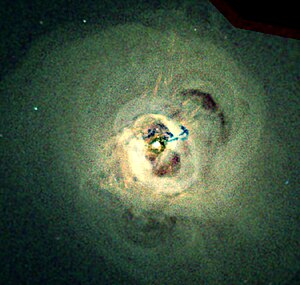Perseus cluster
| Perseus cluster | |
|---|---|

Chandra X-ray Observatory observations of the central regions of the Perseus galaxy cluster. Image is 284 arcsec across. RA 03h 19m 47.60sDec +41° 30' 37.00" in Perseus. Observation dates: 13 pointings between August 8, 2002 and October 20, 2004. Color code: Energy (Red 0.3-1.2 keV, Green 1.2-2 keV, Blue 2-7 keV). Instrument: ACIS.
Credit: NASA/CXC/IoA/A.Fabian et al. |
|
| Observation data (Epoch J2000) | |
| Constellation(s) | Perseus |
| Right ascension | 03hh 18m |
| Declination | +41° 30′ |
| Brightest member | NGC 1275 |
| Number of galaxies | >1000 |
| Richness class | 2 |
| Bautz-Morgan classification | II-III |
| Redshift | 0.01790 (5 366 km/s) |
| Distance (co-moving) |
73.6 Mpc (240.05 Mly) h−1 0.705 |
| X-ray flux | 9.1×10−11erg s−1 cm−2 (2—10 keV) |
| Other designations | |
| Abell 426, NGC 1275 Cluster,LGG 88 | |
| See also: Galaxy groups, Galaxy clusters, List of galaxy clusters | |
The Perseus cluster (Abell 426) is a cluster of galaxies in the constellation Perseus. It has a recession speed of 5,366 km/s and a diameter of 863′. It is one of the most massive objects in the known universe, containing thousands of galaxies immersed in a vast cloud of multimillion degree gas.
The detection of X-ray emission from Per XR-1 occurred during an Aerobee rocket flight on March 1, 1970, the source may be associated with NGC 1275 (Per A, 3C 84), and was reported in 1971. If the source is NGC 1275, Lx ~4 x 1045 ergs/s. More detailed observations from Uhuru confirmed the earlier detection and associated the source with the Perseus cluster. Per X-1 is the galaxy cluster at 4U 0316+41 designated the Perseus cluster, Abell 426, and NGC 1275.
The galaxy cluster is the brightest cluster in the sky when observed in the X-ray band.
The cluster contains the radio source 3C 84 that is currently blowing bubbles of relativistic plasma into the core of the cluster. These are seen as holes in an X-ray image of the cluster, as they push away the X-ray emitting gas. They are known as radio bubbles, because they appear as emitters of radio waves due to the relativistic particles in the bubble. The galaxy NGC 1275 is located at the centre of the cluster, where the X-ray emission is brightest.
In 2003 a team of astronomers led by Dr. Andrew Fabian at Cambridge University discovered one of the deepest notes ever detected, a B♭, after 53 hours of Chandra observations. No human will actually hear the note, because its time period between oscillations is 9.6 million years, which is 57 octaves below the keys in the middle of a piano. The sound waves appear to be generated by the inflation of bubbles of relativistic plasma by the central active galactic nucleus in NGC 1275. The bubbles are visible as ripples in the X-ray band since the X-ray brightness of the intracluster medium that fills the cluster is strongly dependent on the density of the plasma.
...
Wikipedia
